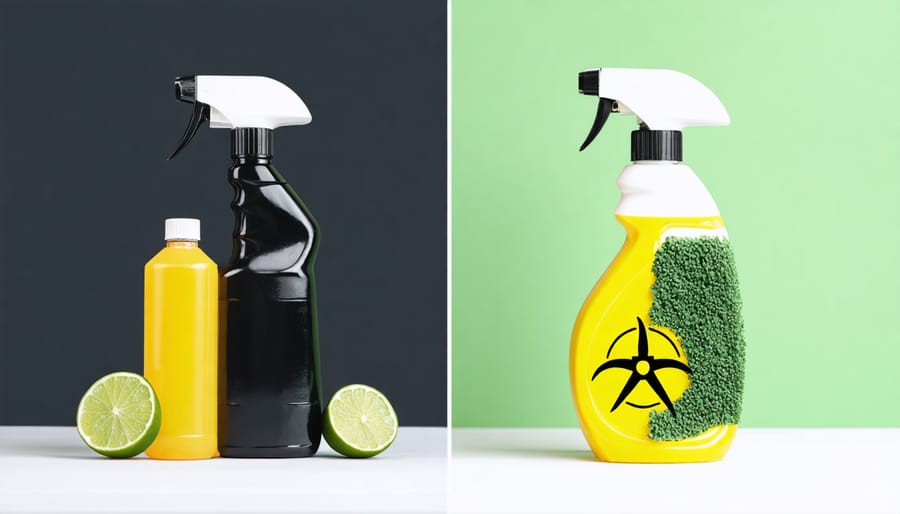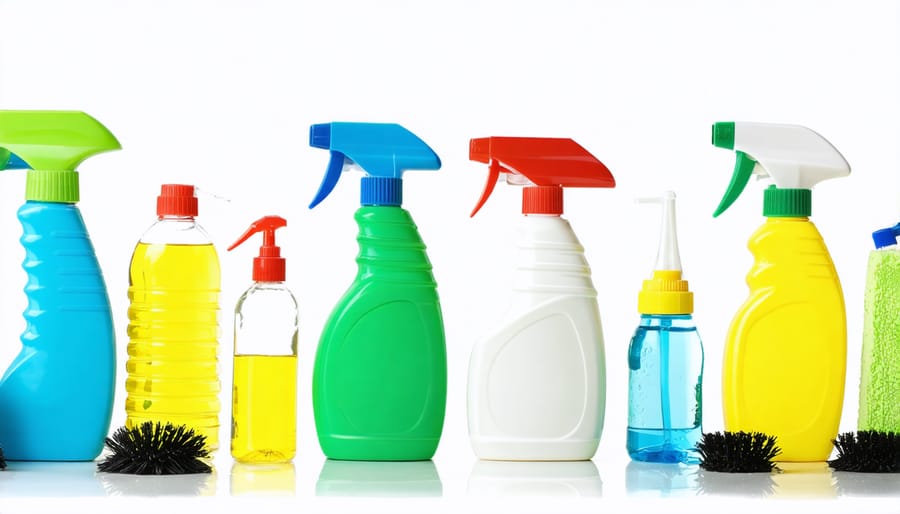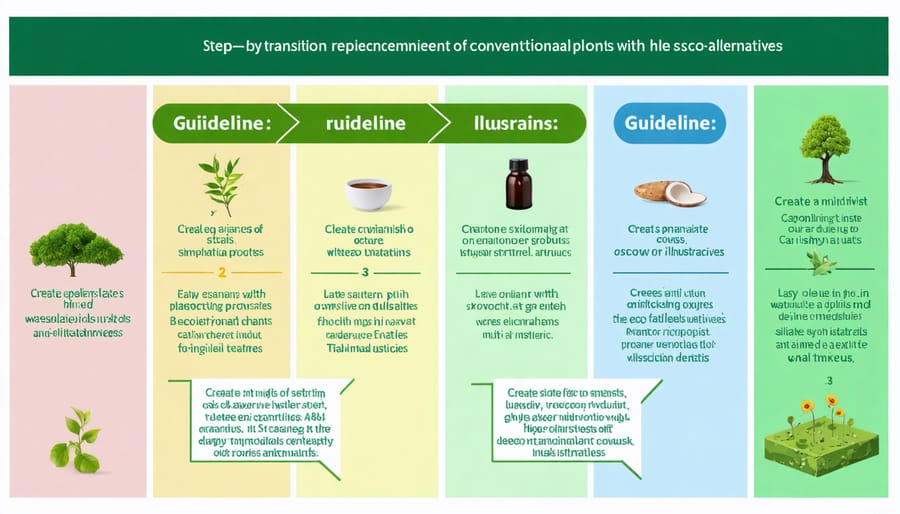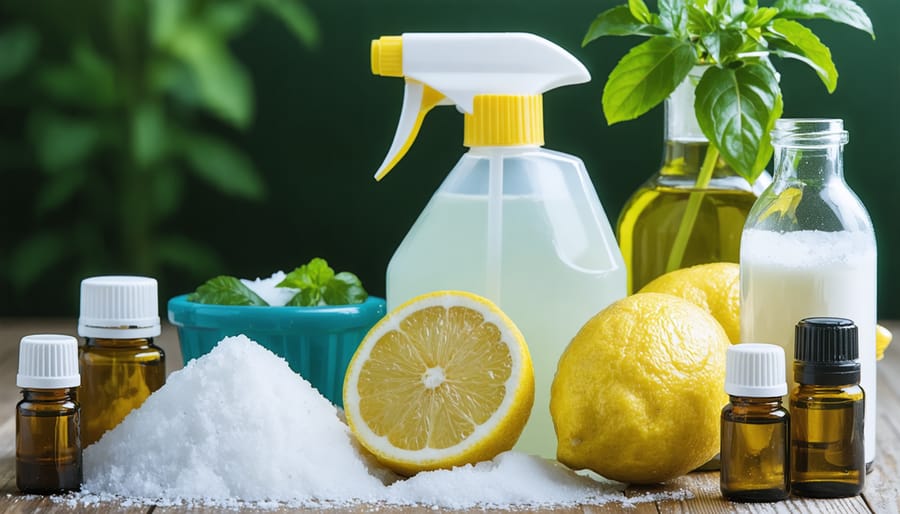Transform your home into a healthier, more sustainable space by switching to eco-friendly cleaning products that harness the power of nature without compromising effectiveness. Traditional cleaning products often harbor harsh chemicals that not only harm our environment but can also impact indoor air quality and family health. Today’s innovative green cleaning solutions combine cutting-edge plant-based formulas with time-tested natural ingredients, delivering professional-grade results while protecting our planet’s delicate ecosystems.
The surge in eco-conscious cleaning products reflects a broader shift toward sustainable living, with studies showing that natural cleaners can be just as effective as conventional options while eliminating toxic residues from our homes. From biodegradable packaging to renewable ingredients, these products offer a complete cleaning solution that aligns with both environmental responsibility and modern lifestyle needs.
Making the switch to green cleaning isn’t just about buying different products – it’s about embracing a more mindful approach to household maintenance. Whether you’re tackling tough kitchen grease or refreshing your bathroom, eco-friendly alternatives now exist for every cleaning challenge. By choosing these products, you’re not only protecting your immediate environment but contributing to larger conservation efforts and supporting companies committed to sustainable practices.
This comprehensive guide will explore the best eco-friendly cleaning products available today, their benefits, and how to integrate them effectively into your cleaning routine, ensuring a cleaner home and a clearer conscience.
Why Traditional Cleaning Products Are Harming Your Home

Hidden Dangers in Your Cleaning Cabinet
Many common household cleaners harbor ingredients that can pose serious risks to our health and the environment. Let’s peek under those familiar labels and discover what’s really hiding in your cleaning cabinet.
Bleach, a cleaning staple, contains chlorine compounds that can irritate your respiratory system and create harmful fumes when mixed with other cleaners. Ammonia, another popular ingredient, can trigger asthma symptoms and cause severe breathing difficulties, especially in enclosed spaces.
Those sweet-smelling air fresheners often contain phthalates, chemicals linked to hormonal disruptions and potential reproductive issues. Meanwhile, many all-purpose cleaners include synthetic fragrances that can trigger allergies and headaches in sensitive individuals.
Perhaps most concerning are ingredients like triclosan (found in antibacterial products) and quaternary ammonium compounds (common in disinfectants), which may contribute to antibiotic resistance and have been linked to reproductive health concerns.
Even your furniture polish might contain petroleum distillates that can cause skin irritation and respiratory problems. The familiar lemon scent often masks these harmful chemicals rather than indicating natural ingredients.
The good news? You don’t have to compromise clean for safe. By understanding these hidden dangers, you can make informed choices about the products you bring into your home. Natural alternatives and eco-friendly options provide effective cleaning power without the health risks, making them a smarter choice for your family and the environment.
Environmental Impact Beyond Your Home
When we wash conventional cleaning products down our drains, they don’t just disappear – they become part of our water systems. These chemicals can harm aquatic life, disrupt ecosystems, and even make their way back into our drinking water. Many traditional cleaners contain phosphates that cause algae blooms in lakes and rivers, depleting oxygen levels for fish and other marine life.
The impact on air quality is equally concerning. Volatile organic compounds (VOCs) from conventional cleaners linger in the air long after we’ve finished cleaning, contributing to indoor and outdoor air pollution. These chemicals can travel far from their original source, affecting air quality in entire neighborhoods and communities.
By switching to eco-friendly cleaning products, you’re not just protecting your immediate environment – you’re contributing to cleaner waterways, healthier air, and a more sustainable future. Every time you choose a green cleaner, you’re preventing harmful chemicals from entering our ecosystem and helping preserve natural habitats for future generations. Small changes in our cleaning routines can create rippling effects that benefit our entire planet.

Top-Performing Eco Green Cleaning Products
All-Purpose Cleaners
All-purpose cleaners are the workhorses of any eco-friendly cleaning arsenal, designed to tackle multiple surfaces while keeping your home and the environment safe. These versatile products have come a long way, with many expert-tested natural cleaners now rivaling their conventional counterparts in effectiveness.
Look for cleaners containing plant-based ingredients like citrus oils, vinegar, and enzymatic cleaners. These natural components break down dirt and grime effectively while being gentle on surfaces and safe for households with children and pets. Popular eco-friendly options include Seventh Generation’s Free & Clear All-Purpose Cleaner, Method’s All-Purpose Natural Surface Cleaner, and Mrs. Meyer’s Multi-Surface Everyday Cleaner.
When choosing an all-purpose cleaner, check for biodegradable formulas and recyclable packaging. The best products will be free from harsh chemicals like phosphates, chlorine, and synthetic fragrances. Many brands now offer concentrated formulas or refill options, reducing plastic waste and making them more cost-effective in the long run.
For best results, pair these cleaners with reusable microfiber cloths rather than disposable wipes. Most eco-friendly all-purpose cleaners work well on countertops, tables, walls, and appliances, though always test on a small area first. Remember that while these products are gentler on the environment, they’re still effective cleaners when used as directed.
Kitchen and Bath Solutions
Your kitchen and bathroom endure the toughest cleaning challenges in your home, but that doesn’t mean you need harsh chemicals to keep them sparkling. Today’s eco-friendly solutions are powerful enough to tackle these high-traffic areas while keeping your family and the environment safe.
For kitchen counters and appliances, vinegar-based cleaners with essential oils like tea tree and lemon work wonders. These natural combinations not only cut through grease but also provide antimicrobial benefits. Look for products containing citrus enzymes, which break down food residue naturally and leave a fresh scent without artificial fragrances.
Bathroom cleaning doesn’t have to be a chemical warfare zone either. Oxygen-based cleaners are excellent for tackling soap scum and mineral deposits while being gentle on surfaces. For toilets, plant-based cleaners containing natural acids from citrus fruits effectively remove stains and kill bacteria without the harsh fumes of conventional cleaners.
Glass surfaces in both rooms deserve special attention. While traditional cleaners often leave streaks, eco-friendly alternatives, including those similar to professional window cleaning solutions, use plant-based surfactants for a crystal-clear finish.
Here are some key ingredients to look for in your kitchen and bath green cleaners:
– Enzymes for breaking down organic matter
– Plant-based surfactants for effective cleaning
– Essential oils for natural fragrance and antimicrobial properties
– Biodegradable ingredients that won’t harm waterways
Remember to choose products in recyclable packaging and consider concentrated formulas to reduce plastic waste. Many eco-friendly brands now offer refill stations or concentrate pouches, making it easier than ever to maintain a sustainable cleaning routine while keeping your high-traffic areas spotless.
Laundry and Fabric Care
When it comes to laundry day, making eco-friendly choices can have a significant impact on our environment. Traditional laundry detergents often contain harsh chemicals that can harm aquatic life and contribute to water pollution. Fortunately, there are numerous green alternatives that clean just as effectively while being gentle on both your clothes and the planet.
Look for plant-based laundry detergents that use enzymes and natural surfactants to break down dirt and stains. These products typically contain ingredients like coconut-derived cleansers, essential oils, and biodegradable compounds. Many eco-friendly brands now offer concentrated formulas, which means less packaging waste and lower transportation emissions.
For fabric softening, ditch chemical-laden dryer sheets in favor of wool dryer balls. These reusable alternatives not only reduce static and wrinkles but also help clothes dry faster, saving energy. Add a few drops of essential oils to the dryer balls for a natural, customizable scent.
Stain removal doesn’t have to involve harsh chemicals either. Try these natural solutions:
– Mix equal parts white vinegar and water for a pre-treatment spray
– Use hydrogen peroxide and baking soda paste for tough stains
– Apply lemon juice to brighten whites naturally
– Tackle grease spots with cornstarch or chalk
When shopping for eco-friendly laundry products, look for these certifications:
– USDA Organic
– EPA Safer Choice
– EcoCert
– Cradle to Cradle
Remember to wash in cold water whenever possible, as this saves energy and helps clothes last longer. Choose the appropriate load size to conserve water, and consider line-drying your clothes when weather permits. These simple changes not only reduce your environmental impact but often save money in the long run.
Storage tip: Keep your eco-friendly laundry products in clear containers and label them clearly. This helps prevent waste and ensures you’re using the right product for each task.
Making the Switch: Tips for Success
Start Small, Win Big
Transitioning to eco-friendly cleaning products doesn’t have to be overwhelming or expensive. Just like our popular home transformation tips, the key is to start small and build momentum. Begin by replacing one conventional cleaning product at a time as it runs out, rather than discarding everything at once.
Start with frequently used items like all-purpose cleaners or dish soap. This approach allows you to test different eco-friendly alternatives without feeling overwhelmed or wasting existing products. As you discover what works best for your needs, gradually expand your green cleaning arsenal.
Keep a simple checklist of products you use regularly and mark which ones you’d like to replace first. When shopping for replacements, look for products with transparent ingredient lists and third-party certifications. Many eco-friendly brands offer starter kits or sample sizes, perfect for testing before committing to full-sized products.
Consider creating a dedicated cleaning caddy for your new eco-friendly products. This helps track what works best and ensures you’re consistently using your green alternatives. Remember, sustainable living is a journey, not a race. Each small change contributes to a healthier home environment and a more sustainable future.

Cost-Saving Strategies
Making the switch to eco-friendly cleaning doesn’t have to strain your wallet. In fact, many green cleaning solutions can help you save money in the long run while protecting the environment. Here’s how to keep your home clean and green on a budget:
Start by embracing DIY cleaning solutions using common household ingredients. Mix equal parts white vinegar and water for an effective all-purpose cleaner, or create a paste with baking soda and water for tough stains. These ingredients cost pennies per use compared to commercial products.
Buy concentrated products that you can dilute at home. While the initial cost might be higher, you’ll get more cleaning power per dollar. Look for bulk options at eco-friendly stores or online retailers, and consider splitting larger quantities with friends or family.
Invest in reusable cleaning tools like microfiber cloths and washable mop heads instead of disposable wipes and pads. Combined with energy-efficient cleaning methods, these sustainable choices can significantly reduce your monthly cleaning expenses.
Join local buy-nothing groups or eco-friendly communities to swap cleaning products and share tips. Many experienced green cleaners are happy to help newcomers with recipes and techniques. Remember, the most sustainable option is often the most economical in the long term, as you’ll buy less and waste less.
Consider starting with one room or one type of cleaning product, gradually transitioning your entire home to eco-friendly alternatives as your budget allows. This approach makes the switch more manageable and lets you perfect your green cleaning routine without overwhelming your finances.

DIY Green Cleaning Solutions
Pantry Ingredients That Clean
Your kitchen pantry is a treasure trove of natural cleaning solutions that are both eco-friendly and budget-conscious. These everyday ingredients can be just as effective as commercial cleaners when used properly in your DIY cleaning techniques.
Baking soda is perhaps the most versatile pantry cleaner, working as a gentle abrasive for scouring sinks and tubs while also absorbing odors from carpets and refrigerators. White vinegar, with its natural acidic properties, cuts through grease, removes mineral deposits, and kills bacteria on various surfaces.
Lemon juice serves as a natural bleaching agent and deodorizer, perfect for tackling cutting boards and brightening white laundry. Coarse salt works wonderfully as an eco-friendly scrub for cast iron pans and wooden cutting boards, while also helping to absorb fresh stains on carpets and upholstery.
Cornstarch isn’t just for cooking – it’s excellent for absorbing grease stains from fabrics and carpets, and can even be used to clean windows when mixed with vinegar. Plain old table salt mixed with hot water makes an effective gargle for sore throats and can clean wicker furniture.
These natural cleaners are particularly appealing because they’re non-toxic, biodegradable, and safe for households with children and pets. Plus, they’re typically much more affordable than commercial green cleaning products. By combining these pantry staples in various ways, you can create effective cleaning solutions for almost every surface in your home while maintaining an eco-conscious lifestyle.
Essential Oil Boosters
Essential oils aren’t just for aromatherapy – they can significantly boost your green cleaning routine with their natural antibacterial and antimicrobial properties. When added to your eco-friendly cleaning solutions, these powerful plant extracts can enhance both cleaning effectiveness and create a naturally fresh environment.
For all-purpose cleaning, try adding 10-15 drops of tea tree oil to your cleaning mixture for its powerful antimicrobial properties. Lemon essential oil works wonders on grease and grime while leaving a fresh, clean scent. For bathroom cleaning, eucalyptus oil is excellent for tackling mold and mildew, while lavender provides both cleaning power and a calming atmosphere.
Here’s a simple recipe to get started: Mix 2 cups of water, 1/4 cup of white vinegar, and 15 drops of your chosen essential oil in a spray bottle. Some powerful combinations include:
– Lemon + tea tree for kitchen surfaces
– Lavender + peppermint for bathrooms
– Orange + clove for living areas
– Eucalyptus + tea tree for shower areas
Remember to always use high-quality, pure essential oils and store your cleaning solutions in dark glass bottles to preserve their effectiveness. Start with smaller amounts and adjust based on your preferences, as essential oils are highly concentrated. Never use them undiluted, and always test on a small area first to ensure compatibility with your surfaces.
Making the switch to eco-friendly cleaning products isn’t just a trend – it’s a meaningful step toward protecting our planet and creating a healthier home environment. Throughout this guide, we’ve explored how green cleaning solutions can effectively tackle household messes while minimizing environmental impact and reducing exposure to harmful chemicals.
Remember that sustainable cleaning isn’t an all-or-nothing commitment. Start small by replacing one conventional product at a time with a greener alternative. Whether you choose to make your own cleaning solutions using simple ingredients like vinegar and baking soda, or opt for certified eco-friendly brands, every sustainable choice makes a difference.
Pay attention to product labels, certifications, and ingredients lists when shopping for green cleaning products. Look for biodegradable formulas, minimal packaging, and natural ingredients you can recognize. Consider investing in reusable cleaning tools like microfiber cloths and refillable bottles to further reduce waste.
The benefits of eco-friendly cleaning extend beyond environmental protection. These products often work just as effectively as conventional cleaners while being gentler on surfaces, safer for children and pets, and better for indoor air quality. Plus, many green cleaning solutions are more cost-effective in the long run, especially when you make your own.
As you continue your journey toward a more sustainable household, remember that small changes add up to significant impact. Share your experiences with friends and family, and don’t be afraid to experiment with different eco-friendly products until you find what works best for your home. Together, we can create cleaner, healthier spaces while protecting our planet for future generations.
